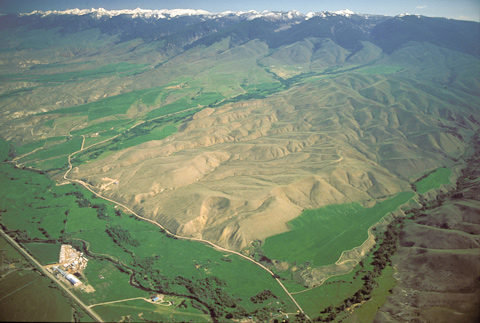With the peaks and ridges of the partially snow-clad Beaverhead Range on the eastern horizon, Lewis and his four companions crossed over the dividing ridge on the west side of the upper Missouri River basin and the Columbia drainage, then descended a dusty, well-traveled Indian road for some miles down into a “handsome little valley” among the sources of the Columbia River basin. Lewis recorded that the soil was so poor as to produce “little else but prickly pears, and bearded grass about 3 inches high.”
In his journal entry for 13 August 1805, Lewis wrote a detailed record of the discoveries he made that pivotal Tuesday. In addition to notations on the area’s geography and flora, he wrote accounts of his first three encounters with the Lemhi Shoshones. The day climaxed with an elaborate pipe-smoking ceremony as a preamble to long diplomatic exchanges via Plains Sign Language.
Chief Cameahwait (who proved to be Sacagawea‘s brother) disclosed that there was no viable riverine route out of the valley.[1]See also Cameahwait’s Geography Lesson and Salmon River. He also reported on a recent raid by some Blackfeet, in which twenty Shoshones were killed or captured, all but one of their leather tepees were destroyed, and many horses were stolen. Nevertheless, it appeared to Lewis that they might still have enough horses to share with the Corps should a long overland portage be necessary.
In a gesture of kindness and fellowship, after he returned to his lodge “an indian called me in to his bower and gave me a small morsel of the flesh of an antelope boiled, and a piece of fresh salmon roasted; both of which I eat with a very good relish.” Considering all that had transpired during those first three days he spent among Sacagawea’s people, there was no need of an epiphany. But that first taste of roasted salmon must have marked one of the most soul-satisfying moments he had experienced since leaving St. Louis. At that moment when he lifted it to his lips he was miraculously, even mystically, linked with his destination, though it was still hundreds of miles away. “[T]his was the first salmon I had seen,” he wrote, and it “perfectly convinced me that we were on the waters of the Pacific Ocean.”
From Discovering Lewis & Clark from the Air
Photography by Jim Wark
Text by Joseph Mussulman
Reproduced by permission of Mountain Press
Notes
| ↑1 | See also Cameahwait’s Geography Lesson and Salmon River. |
|---|
Experience the Lewis and Clark Trail
The Lewis and Clark Trail Experience—our sister site at lewisandclark.travel—connects the world to people and places on the Lewis and Clark Trail.
Discover More
- The Lewis and Clark Expedition: Day by Day by Gary E. Moulton (University of Nebraska Press, 2018). The story in prose, 14 May 1804–23 September 1806.
- The Lewis and Clark Journals: An American Epic of Discovery (abridged) by Gary E. Moulton (University of Nebraska Press, 2003). Selected journal excerpts, 14 May 1804–23 September 1806.
- The Lewis and Clark Journals. by Gary E. Moulton (University of Nebraska Press, 1983–2001). The complete story in 13 volumes.


